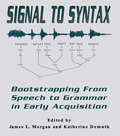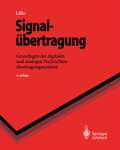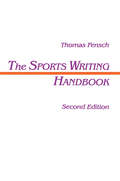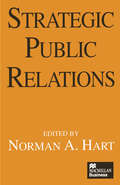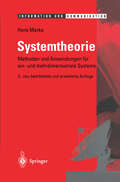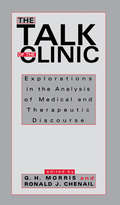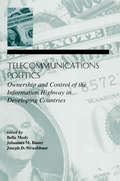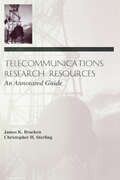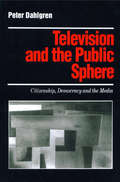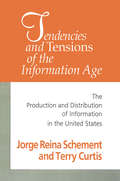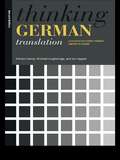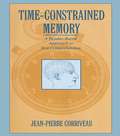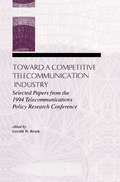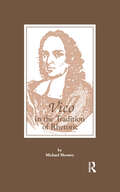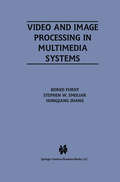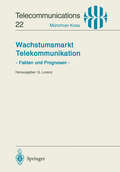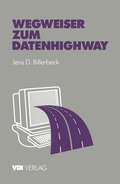- Table View
- List View
Signal to Syntax: Bootstrapping From Speech To Grammar in Early Acquisition
by James L. Morgan Katherine DemuthIn the beginning, before there are words, or syntax, or discourse, there is speech. Speech is an infant's gateway to language. Without exposure to speech, no language--or at most only a feeble facsimile of language--develops, regardless of how rich a child's biological endowment for language learning may be. But little is given directly in speech--not words, for example, as anyone who has ever listened to fluent conversation in an unfamiliar language can attest. Rather, words and phrases, or rudimentary categories--or whatever other information is required for syntactic and semantic analyses to begin operating--must be pulled from speech through an infant's developing perceptual capacities. By the end of the first year, an infant can segment at least some words from fluent speech. Beyond this, how impoverished or rich an infant's representations of input may be remains largely unknown. Clearly, in the debate over determinants of early language acquisition, the input speech stream has too often been offhandedly dismissed as a potential source of information.This volume brings together internationally-known scholars from a range of disciplines--linguistics, psychology, cognitive and computer science, and acoustics --who share common interests in how speech, in its phonological, prosodic, distributional, and statistical properties, may encode information useful for early language learning, and how such information may be deciphered by very young children. These scholars offer a spectrum of viewpoints on the possibility that aspects of speech may provide bootstraps for language learning; contribute important, state-of-the-art findings across a variety of relevant domains; and illuminate critical directions for future inquiry. The publication of this volume represents a significant step in renewing the bonds between two fields that have long been sundered--speech perception and language acquisition.
Signalübertragung: Grundlagen der digitalen und analogen Nachrichtenübertragungssysteme (Springer-Lehrbuch)
by Jens Ohm Hans Dieter LükeDieses seit nunmehr zwanzig Jahren bekannte Standardlehrbuch der Signalübertragung ist auch in der sechsten, neubearbeiteten und erweiterten Auflage die grundlegende Einführung in die Theorie der Nachrichtenübertragung. Studenten der Elektrotechnik und der Physik sowie Praktikern aus Industrie und Forschung vermittelt dieses didaktisch hervorragend konzipierte und bewährte Lehrbuch das benötigte Wissen. Übungen mit ausführlichen Lösungswegen sowie ein auf den aktuellen Stand gebrachtes Verzeichnis weiterführender Literatur runden das Buch ab.
The Sports Writing Handbook
by Thomas FenschCompletely revised and updated in a second edition, this volume represents the only book ever written that analyzes sports writing and presents it as "exceptional" writing. Other books discuss sports writers as "beat reporters" in one area of journalism, whereas this book shows aspiring sports writers a myriad of techniques to make their writing stand out. It takes the reader through the entire process of sports writing: observation, interviewing techniques, and various structures of articles; types of "leads;" transitions within an article; types of endings; use of statistics; do's and don'ts of sports writing; and many other style and technique points. This text provides over 100 examples of leads drawn from newspapers and magazines throughout the country, and also offers up-to-date examples of sports jargon from virtually every major and minor sport played in the U.S.
The Sports Writing Handbook
by Thomas FenschCompletely revised and updated in a second edition, this volume represents the only book ever written that analyzes sports writing and presents it as "exceptional" writing. Other books discuss sports writers as "beat reporters" in one area of journalism, whereas this book shows aspiring sports writers a myriad of techniques to make their writing stand out. It takes the reader through the entire process of sports writing: observation, interviewing techniques, and various structures of articles; types of "leads;" transitions within an article; types of endings; use of statistics; do's and don'ts of sports writing; and many other style and technique points. This text provides over 100 examples of leads drawn from newspapers and magazines throughout the country, and also offers up-to-date examples of sports jargon from virtually every major and minor sport played in the U.S.
Strategic Public Relations
by Norman HartStrategic Public Relations has been produced as a core book for what will become a series of second generation books treating public relations as a new, and separate discipline which has strategic implications for the whole business. Written primarily for senior executives and PR practitioners, Strategic Public Relations also serves students and young executives, covering such topics as: corporate goals and strategies; marketing communications; financial public relations; employee and local community relations; parliamentary and EU relations; building an international reputation; corporate advertising; sponsorship and media relations; communications research and corporate responsibility. All of the 16 contributors to this book, in addition to being recognised authorities in their fields, are senior practitioners. They will broaden your business horizons by showing you that corporate relations, if done properly, will lead to improved efficiency, improved competitive performance and, ultimately, to greater profit.
Systemtheorie: Methoden und Anwendungen für ein- und mehrdimensionale Systeme (Information und Kommunikation)
by Hans MarkoDieser Klassiker der Systemtheorie wurde auf den neuesten Stand gebracht und um ein Kapitel über mehrdimensionale Systeme erweitert. Zentrales Thema ist die grundlegende und umfassende Darstellung der Behandlung linearer Systeme mittels Spektraltransformationen. Diese müssen nicht nachrichten-, informations-, oder regelungstechnischer, sondern können z.B. auch biologischer Natur sein.Auf eine kompakte Darstellung wurde besonderer Wert gelegt, die Ansprüche an die Mathematikkenntnisse des Lesers sind gering. Das Buch ist somit sowohl als Nachschlagewerk als auch zum Lernen geeignet.
The Talk of the Clinic: Explorations in the Analysis of Medical and therapeutic Discourse (Routledge Communication Series)
by G. H. MorrisThis collection of original papers by scholars who closely analyze the talk of the clinic features studies that were conceived with the aim of contributing to clinical practitioners' insight about how their talk works. No previous communication text has attempted to take such a practitioner-sensitive posture with its research presentations. Each chapter focuses on one or more performances that clinical practitioners -- in consort with their clients or colleagues -- must achieve with some regularity. These speech acts are consequential for effective practice and sometimes present themselves as problematic. Rather than calling for research to be simplified or reoriented in order for practitioners to understand it, these authors interpret state-of-the-art descriptive analysis for its practical import for clinicians. Each contributor delves deeply into clinical practice and its wisdom; therefore, each is positioned to identify alternative clinical practices and techniques and to appreciate practitioners' means of performing effectively. When reflective practitioners encounter these new pieces of work, productive alterations in how their work is done can be stimulated. By reading this work, reflective practitioners will now have new ways of considering their talk and new possibilities for speaking effectively. The volume is uniquely constructed so as to engage in dialogue with these reflective practitioners as they struggle to articulate their work. A practical wisdom-as-research trend has recently emerged in the clinical fields stimulating these practitioners to explore new and more informative ways -- communication and literary theory, ethnography, and discourse analysis -- to express what they do in clinics and hospitals. With the studies presented in this book, the editors build upon this dialectical process between practitioner and researcher, thus helping this productive conversation to continue.
The Talk of the Clinic: Explorations in the Analysis of Medical and therapeutic Discourse (Routledge Communication Series)
by Ronald J. Chenail G. H. MorrisThis collection of original papers by scholars who closely analyze the talk of the clinic features studies that were conceived with the aim of contributing to clinical practitioners' insight about how their talk works. No previous communication text has attempted to take such a practitioner-sensitive posture with its research presentations. Each chapter focuses on one or more performances that clinical practitioners -- in consort with their clients or colleagues -- must achieve with some regularity. These speech acts are consequential for effective practice and sometimes present themselves as problematic. Rather than calling for research to be simplified or reoriented in order for practitioners to understand it, these authors interpret state-of-the-art descriptive analysis for its practical import for clinicians. Each contributor delves deeply into clinical practice and its wisdom; therefore, each is positioned to identify alternative clinical practices and techniques and to appreciate practitioners' means of performing effectively. When reflective practitioners encounter these new pieces of work, productive alterations in how their work is done can be stimulated. By reading this work, reflective practitioners will now have new ways of considering their talk and new possibilities for speaking effectively. The volume is uniquely constructed so as to engage in dialogue with these reflective practitioners as they struggle to articulate their work. A practical wisdom-as-research trend has recently emerged in the clinical fields stimulating these practitioners to explore new and more informative ways -- communication and literary theory, ethnography, and discourse analysis -- to express what they do in clinics and hospitals. With the studies presented in this book, the editors build upon this dialectical process between practitioner and researcher, thus helping this productive conversation to continue.
Telecommunications Politics: Ownership and Control of the information Highway in Developing Countries (Lea Telecommunications Ser.)
by Bella Mody Johannes M. Bauer Joseph D. StraubhaarThis volume brings together scholars and policymakers to address the issue of telecommunications policy in developing countries. It elaborates on the position that economics and technology determine the framework for discussion, but politics makes the decision. Politics, in this case, refers to the dynamics of the power structure generated by the h
Telecommunications Politics: Ownership and Control of the information Highway in Developing Countries
by Bella Mody Johannes M. Bauer Joe StraubhaarThis volume brings together scholars and policymakers to address the issue of telecommunications policy in developing countries. It elaborates on the position that economics and technology determine the framework for discussion, but politics makes the decision. Politics, in this case, refers to the dynamics of the power structure generated by the h
Telecommunications Research Resources: An Annotated Guide
by James K. Bracken Christopher H. SterlingAs the telecommunication and information field expands and becomes more varied, so do publications about these technologies and industries. This book is a first attempt to provide a general guide to that wealth of English-language publications -- both books and periodicals -- on all aspects of telecommunication. It is a comprehensive, evaluative sourcebook for telecommunications research in the United States that brings together a topically-arranged, cross-referenced, and indexed volume in one place. The information provided is only available by consulting a succession of different directories, guides, bibliographies, yearbooks, and other resources. On the one hand, it is a directory that describes in detail the major entities that comprise the American telecommunication research infrastructure including federal and state government offices and agencies, and private, public, and corporate research institutions. On the other hand, it is a bibliography that identifies and assesses the most important and useful reference and critical resources about U.S. telecommunication history, technology, industry and economics, social applications and impacts, plus policy, law and regulations, and role in the global telecommunication marketplace. No existing guide covers all of these aspects in the depth and detail of this volume.
Telecommunications Research Resources: An Annotated Guide
by James K. Bracken Christopher H. SterlingAs the telecommunication and information field expands and becomes more varied, so do publications about these technologies and industries. This book is a first attempt to provide a general guide to that wealth of English-language publications -- both books and periodicals -- on all aspects of telecommunication. It is a comprehensive, evaluative sourcebook for telecommunications research in the United States that brings together a topically-arranged, cross-referenced, and indexed volume in one place. The information provided is only available by consulting a succession of different directories, guides, bibliographies, yearbooks, and other resources. On the one hand, it is a directory that describes in detail the major entities that comprise the American telecommunication research infrastructure including federal and state government offices and agencies, and private, public, and corporate research institutions. On the other hand, it is a bibliography that identifies and assesses the most important and useful reference and critical resources about U.S. telecommunication history, technology, industry and economics, social applications and impacts, plus policy, law and regulations, and role in the global telecommunication marketplace. No existing guide covers all of these aspects in the depth and detail of this volume.
Television and the Public Sphere: Citizenship, Democracy and the Media (PDF)
by Peter DahlgrenIn this broad-ranging text, Peter Dahlgren clarifies the underlying theoretical concepts of civil society and the public sphere, and relates these to a critical analysis of the practice of television as journalism, as information and as entertainment. He demonstrates the limits and the possibilities of the television medium and the formats of popular journalism. These issues are linked to the potential of the audience to interpret or resist messages, and to construct its own meanings. What does a realistic understanding of the functioning and the capabilities of television imply for citizenship and democracy in a mediated age?
Tendencies and Tensions of the Information Age: Production and Distribution of Information in the United States
by Jorge Reina Schement Terry CurtisThe development of technology and the hunger for information has caused a wave of change in daily life in America. Nearly every American's environment now consists of cable television, video cassette players, answering machines, fax machines, and personal computers. Schement and Curtis argue that the information age has evolved gradually throughout the twentieth century. National focus on the production and distribution of information stems directly from the organizing principles and realities of the market system, not from a revolution sparked by the invention of the computer.Now available in paperback, Tendencies and Tensions of the Information Age, brings together findings from many disciplines, including classical studies, etymology, political sociology, and macroeconomics. This valuable resource will be enjoyed by sociologists, historians, and scholars of communication and information studies.
Tendencies and Tensions of the Information Age: Production and Distribution of Information in the United States
by Jorge Reina SchementThe development of technology and the hunger for information has caused a wave of change in daily life in America. Nearly every American's environment now consists of cable television, video cassette players, answering machines, fax machines, and personal computers. Schement and Curtis argue that the information age has evolved gradually throughout the twentieth century. National focus on the production and distribution of information stems directly from the organizing principles and realities of the market system, not from a revolution sparked by the invention of the computer.Now available in paperback, Tendencies and Tensions of the Information Age, brings together findings from many disciplines, including classical studies, etymology, political sociology, and macroeconomics. This valuable resource will be enjoyed by sociologists, historians, and scholars of communication and information studies.
Thinking German Translation: A Course in Translation Method (Thinking Translation)
by Sándor Hervey Mr Ian Higgins Ian Higgins Michael LoughridgeThinking German Translation is a comprehensive and revolutionary 20-week course in translation method offering a challenging and entertaining approach to the acquisition of translation skills. It has been fully and successfully piloted at the University of St.Andrews.Translation is presented as a problem-solving discipline. Discussion, examples and a full range of exercise work enable students to acquire the skills necessary for a broad range of translation problems.Examples are drawn from a wide variety of material from technical and commercial texts to poetry and song.Thinking German Translation is essential reading for advanced undergraduates and postgraduate students of German. The book will also appeal to a wide range of languages students and tutors through the general discussion of principles, purposes and practice of translation.
Time-constrained Memory: A Reader-based Approach To Text Comprehension
by Jean-Pierre CorriveauThis book tries to answer the question posed by Minsky at the beginning of The Society of Mind: "to explain the mind, we have to show how minds are built from mindless stuff, from parts that are much smaller and simpler than anything we'd considered smart." The author believes that cognition should not be rooted in innate rules and primitives, but rather grounded in human memory. More specifically, he suggests viewing linguistic comprehension as a time-constrained process -- a race for building an interpretation in short term memory. After reviewing existing psychological and computational approaches to text understanding and concluding that they generally rely on self-validating primitives, the author abandons this objectivist and normative approach to meaning and develops a set of requirements for a grounded cognitive architecture. He then goes on to explain how this architecture must avoid all epistemological commitments, be tractable both with respect to space and time, and, most importantly, account for the diachronic and non-deterministic nature of comprehension. In other words, a text may or may not lead to an interpretation for a specific reader, and may be associated with several interpretations over time by one reader. Throughout the remainder of the book, the author demonstrates that rules for all major facets of comprehension -- syntax, reference resolution, quantification, lexical and structural disambiguation, inference and subject matter -- can be expressed in terms of the simple mechanistic computing elements of a massively parallel network modeling memory. These elements, called knowledge units, work in a limited amount of time and have the ability not only to recognize but also to build the structures that make up an interpretation. Designed as a main text for graduate courses, this volume is essential to the fields of cognitive science, artificial intelligence, memory modeling, text understanding, computational linguistics and natural language understanding. Other areas of application are schema-matching, hermeneutics, local connectionism, and text linguistics. With its extensive bibliography, the book is also valuable as supplemental reading for introductory undergraduate courses in cognitive science and computational linguistics.
Time-constrained Memory: A Reader-based Approach To Text Comprehension
by Jean-Pierre CorriveauThis book tries to answer the question posed by Minsky at the beginning of The Society of Mind: "to explain the mind, we have to show how minds are built from mindless stuff, from parts that are much smaller and simpler than anything we'd considered smart." The author believes that cognition should not be rooted in innate rules and primitives, but rather grounded in human memory. More specifically, he suggests viewing linguistic comprehension as a time-constrained process -- a race for building an interpretation in short term memory. After reviewing existing psychological and computational approaches to text understanding and concluding that they generally rely on self-validating primitives, the author abandons this objectivist and normative approach to meaning and develops a set of requirements for a grounded cognitive architecture. He then goes on to explain how this architecture must avoid all epistemological commitments, be tractable both with respect to space and time, and, most importantly, account for the diachronic and non-deterministic nature of comprehension. In other words, a text may or may not lead to an interpretation for a specific reader, and may be associated with several interpretations over time by one reader. Throughout the remainder of the book, the author demonstrates that rules for all major facets of comprehension -- syntax, reference resolution, quantification, lexical and structural disambiguation, inference and subject matter -- can be expressed in terms of the simple mechanistic computing elements of a massively parallel network modeling memory. These elements, called knowledge units, work in a limited amount of time and have the ability not only to recognize but also to build the structures that make up an interpretation. Designed as a main text for graduate courses, this volume is essential to the fields of cognitive science, artificial intelligence, memory modeling, text understanding, computational linguistics and natural language understanding. Other areas of application are schema-matching, hermeneutics, local connectionism, and text linguistics. With its extensive bibliography, the book is also valuable as supplemental reading for introductory undergraduate courses in cognitive science and computational linguistics.
Toward A Competitive Telecommunication Industry: Selected Papers From the 1994 Telecommunications Policy Research Conference (LEA Telecommunications Series)
by Gerald W. BrockProviding an authoritative perspective on the best current research regarding telecommunication policy, this book is based on the 22nd Annual Telecommunications Policy Research Conference. The papers focus on the critical policy issues created by increasing competition in the industry. The book contains a careful analysis of local competition and interconnection, international competition, universal service issues, the Internet and emerging new methods of communication, and the first amendment problems created by changing telecommunication technology. It brings together -- in a convenient form -- a wide range of important scholarship on telecommunication policy that otherwise would require extensive research into a variety of journals, government filings, and unpublished papers.
Toward A Competitive Telecommunication Industry: Selected Papers From the 1994 Telecommunications Policy Research Conference (LEA Telecommunications Series)
by Gerald W. BrockProviding an authoritative perspective on the best current research regarding telecommunication policy, this book is based on the 22nd Annual Telecommunications Policy Research Conference. The papers focus on the critical policy issues created by increasing competition in the industry. The book contains a careful analysis of local competition and interconnection, international competition, universal service issues, the Internet and emerging new methods of communication, and the first amendment problems created by changing telecommunication technology. It brings together -- in a convenient form -- a wide range of important scholarship on telecommunication policy that otherwise would require extensive research into a variety of journals, government filings, and unpublished papers.
Vico in the Tradition of Rhetoric
by Michael MooneyIf among the many truths of Giambattista Vico's New Science there is one that is deepest, it is the truth that language, mind, and society are but three modes of a common reality. In Vico's term, that reality is the monde civile, the world of man. It is a world of many guises and faces. If reflected in a mirror, those faces would reveal an image of the full array of contemporary arts and sciences, all the disciplines of learning and technique by which, so Vico judged, humanity attains its perfection. Humanity in its perfection, however, is so rare a moment, so delicate and subtle a state, that it is never to be found among the nations of the world -- or is found in so fragile a form that it threatens always to crack and fall to the ground. In the West, a persistent line of thinking that has flourished from time to time holds that language is primary in culture, metaphor a necessity, and jurisprudence our highest achievement. This was the position of Vico, who not only received and cherished the tradition, but looked deeply into it, saw what its principles implied, and so made ready for the great social theorists of the nineteenth century. That is the thesis of this work. After an introductory chapter on Vico himself -- in which his intellectual world and his movements within it are sketched -- the work unfolds in three parts. These parts successively treat rhetoric, pedagogy, and culture, each proceeding from a major Vichian text.
Vico in the Tradition of Rhetoric
by Michael MooneyIf among the many truths of Giambattista Vico's New Science there is one that is deepest, it is the truth that language, mind, and society are but three modes of a common reality. In Vico's term, that reality is the monde civile, the world of man. It is a world of many guises and faces. If reflected in a mirror, those faces would reveal an image of the full array of contemporary arts and sciences, all the disciplines of learning and technique by which, so Vico judged, humanity attains its perfection. Humanity in its perfection, however, is so rare a moment, so delicate and subtle a state, that it is never to be found among the nations of the world -- or is found in so fragile a form that it threatens always to crack and fall to the ground. In the West, a persistent line of thinking that has flourished from time to time holds that language is primary in culture, metaphor a necessity, and jurisprudence our highest achievement. This was the position of Vico, who not only received and cherished the tradition, but looked deeply into it, saw what its principles implied, and so made ready for the great social theorists of the nineteenth century. That is the thesis of this work. After an introductory chapter on Vico himself -- in which his intellectual world and his movements within it are sketched -- the work unfolds in three parts. These parts successively treat rhetoric, pedagogy, and culture, each proceeding from a major Vichian text.
Video and Image Processing in Multimedia Systems (The Springer International Series in Engineering and Computer Science #326)
by Borko Furht Stephen W. Smoliar HongJiang ZhangVideo and Image Processing in Multimedia Systems treats a number of critical topics in multimedia systems, with respect to image and video processing techniques and their implementations. These techniques include: Image and video compression techniques and standards, and Image and video indexing and retrieval techniques. Video and Image Processing in Multimedia Systems is divided into three parts. Part I serves as an introduction to multimedia systems, discussing basic concepts, multimedia networking and synchronization, and an overview of multimedia applications. Part II presents comprehensive coverage of image and video compression techniques and standards, their implementations and applications. Because multimedia data (specifically video and images) require efficient compression techniques in order to be stored and delivered in real-time, video and image compression is a crucial element of an effective multimedia system. In Part III attention is focused on the semantic nature of image and video source material, and how that material may be effectively indexed and retrieved. Topics discussed include static images, full-motion video, and the manner in which compressed representations can facilitate structural analysis. Part III concludes with an extended discussion of a case study. This book serves as an invaluable reference with respect to the most important standards in the field. Video and Image Processing in Multimedia Systems is suitable as a textbook for course use.
